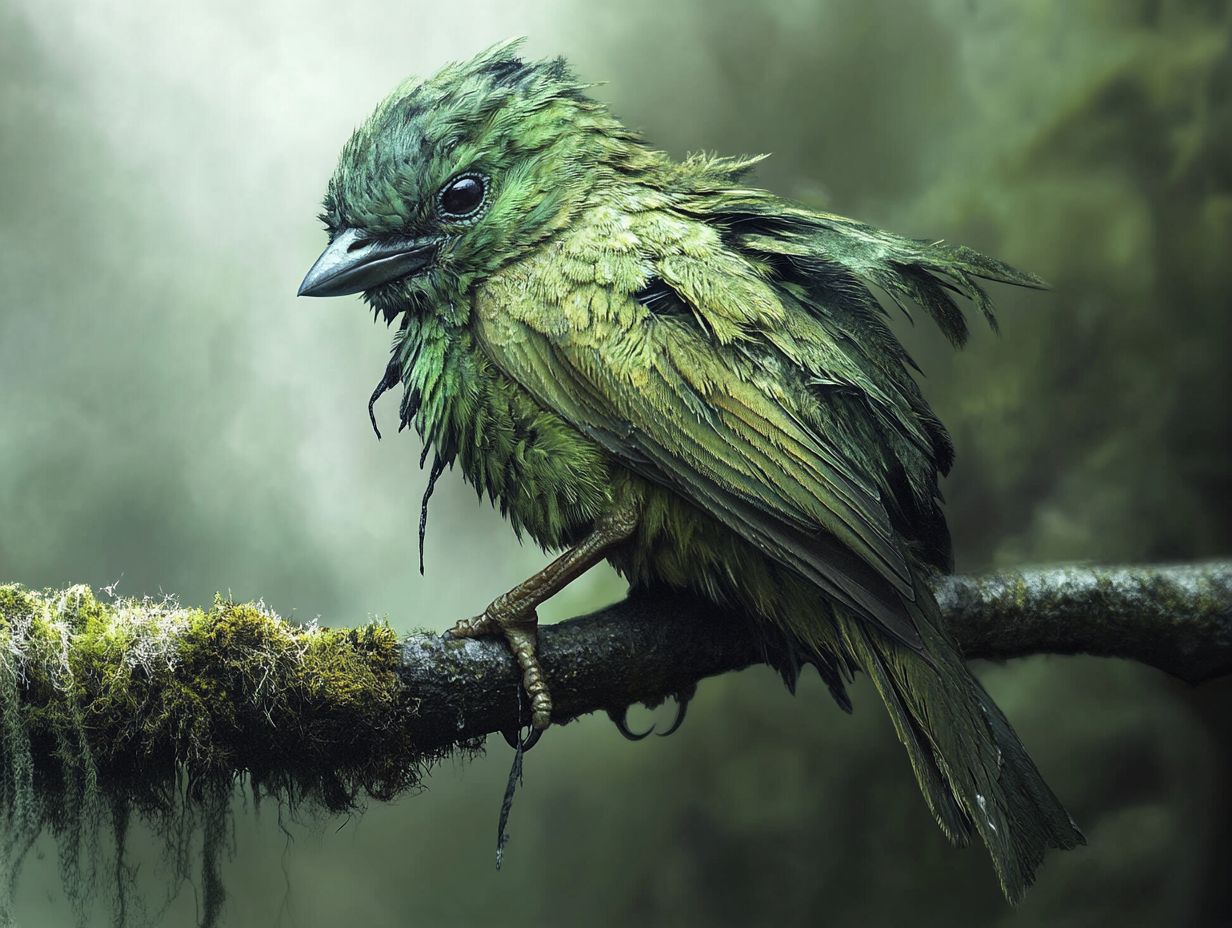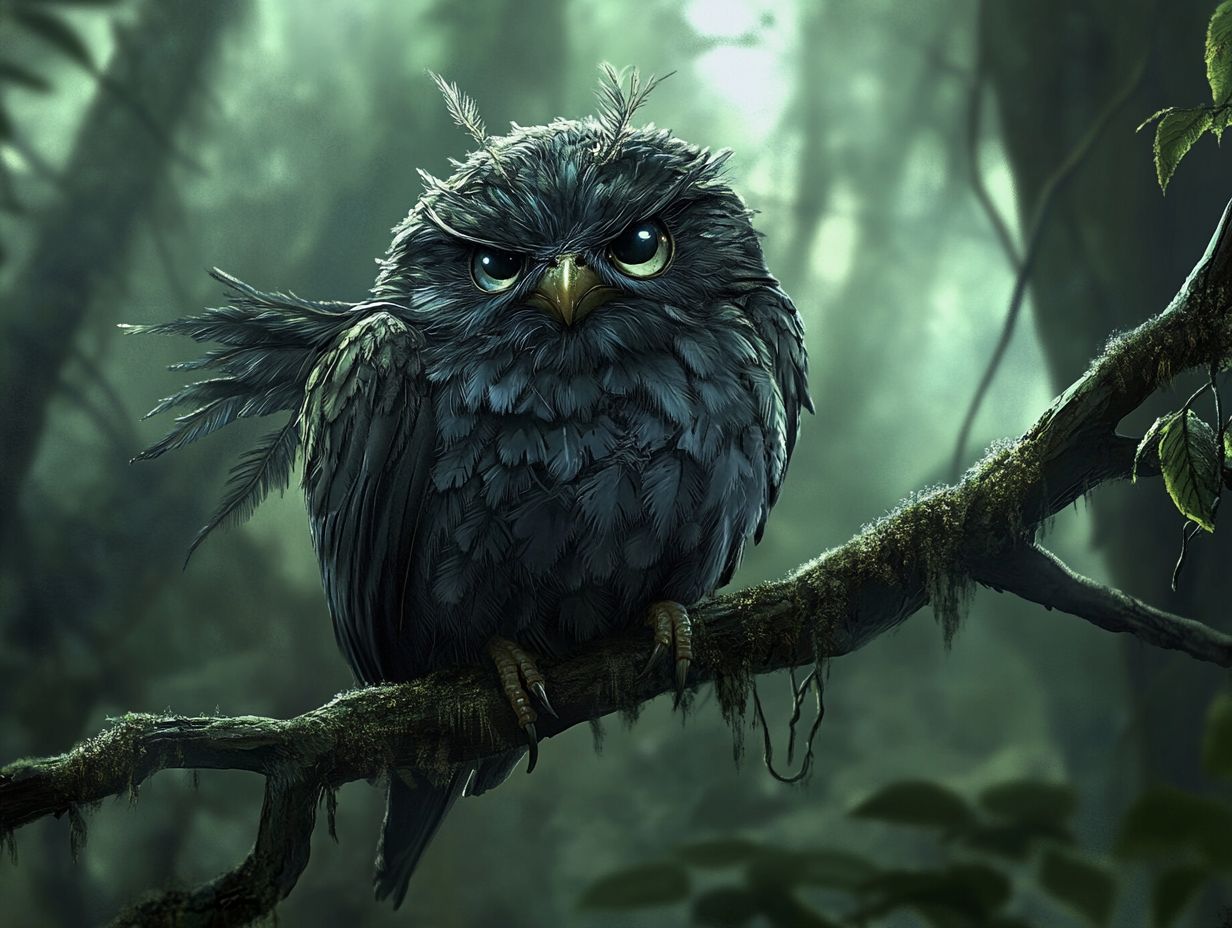How to Identify Common Bird Injuries
Birds are delicate creatures. Understanding their injuries is essential for their well-being.
This guide explores the various types of injuries birds commonly encounter. You ll learn to recognize both physical and behavioral signs of injury and vital first aid techniques for immediate care.
It also shows when to seek professional help. Plus, you’ll find tips for creating a safe environment that prevents injuries.
Whether you re a dedicated bird owner or a wildlife enthusiast, this info empowers you to protect these magnificent animals.
Contents
Key Takeaways:

- Be aware of the types of bird injuries and how they occur to better identify common injuries in your feathered friends.
- Recognize signs of injury, such as limping or changes in eating habits, to provide timely first aid.
- Basic first aid techniques, like cleaning and bandaging wounds, can help alleviate pain and promote healing.
Understanding Common Bird Injuries
Knowing about common bird injuries is vital for anyone who cares about local wildlife. Many birds, like adult songbirds, face various hazards that can lead to injury or orphaning.
Climate change and habitat loss significantly challenge birds. Wildlife rehabilitators, such as those at the Wild Bird Fund and Wildlife Trusts, work hard to care for injured birds.
Nestlings and fledglings are especially vulnerable. They often need immediate help when found alone or injured, making awareness of these injuries crucial for their survival.
Types of Injuries and How They Occur
Injured birds can face various injuries, often due to encounters with house cats, dogs, or collisions with windows and vehicles.
These events can lead to serious issues, like severe fractures, puncture wounds, and even internal injuries. For example, a bird that flies into a window might get a wing fracture, while an attack from a pet could cause deep cuts.
Signs of shock include labored breathing, disorientation, or a rapid heartbeat. Understanding these risks is essential, as many domestic animals and environmental hazards threaten birds. This highlights the need for effective care from rehabilitation centers.
Signs of a Bird Injury
Recognizing the signs of a bird injury is vital for timely intervention. Injured birds often show physical and behavioral signs of distress. Look for signs like difficulty flying, abnormal positioning, or unusual sounds.
When you find an injured bird, assess its condition carefully. Give it space to reduce stress and be mindful of legal considerations in handling wild birds. Your awareness can significantly assist local wildlife rehabilitators.
Physical and Behavioral Indicators

Physical and behavioral signs of an injured bird may include a drooping wing, difficulty maintaining balance, or unusual vocalizations. Each of these is an urgent call for immediate assistance.
You might also notice other indicators, such as ruffled feathers, which often signal discomfort or distress. A noticeable limp likely points to an underlying injury. If you observe a bird that seems withdrawn or lethargic, rather than actively engaging with its environment, it provides additional insights into its well-being.
If you encounter unexpected aggression, that may be a protective response to pain. Approach the situation with care, giving the bird the space it needs while monitoring its condition for any significant changes that could necessitate help.
First Aid for Injured Birds
Administering first aid to injured birds can dramatically improve their chances of recovery. It starts with a solid grasp of basic first aid steps and the safe transport of an injured bird to a wildlife rehabilitator.
When you come across an injured bird, your first priority should be to prevent any further harm by securing the area and gently handling the bird with gloves. Your knowledge and actions can truly make a pivotal difference in the bird’s rehabilitation journey.
Basic First Aid Techniques
Basic first aid steps for birds involve gently catching an injured bird using a towel and ensuring it is securely contained during transport to prevent further injury.
To begin, approach the bird quietly to minimize stress and enhance safety. With a soft towel in hand, carefully cover the bird, restricting its movement without causing harm. This towel serves as a protective barrier, offering comfort while preventing escape attempts.
Once you’ve successfully captured it, place the bird in a sturdy, well-ventilated container lined with a soft cloth to provide additional cushioning during transport.
It’s crucial to avoid direct sunlight and excessive noise, creating a calm environment that facilitates a smoother journey to the wildlife rehabilitation center. Always remember, your primary goal is to minimize anxiety while ensuring that the bird’s injuries are stabilized.
When to Seek Professional Help
Understanding when to seek professional assistance for an injured bird is crucial. The expertise of local wildlife rehabilitators, such as those at the Wild Bird Fund and Wildlife Trusts, is invaluable, particularly when assessing the severity of an injury.
Many injuries aren’t immediately visible, and what appears to be a minor issue could be serious underneath the surface. Therefore, consulting a professional for a thorough evaluation and appropriate care is essential.
Determining the Severity of the Injury

Determining the severity of an injury in an injured bird requires your keen eye and thoughtful assessment of its physical condition. As you assess the situation, you’ll find that this is a critical role in understanding the bird’s needs effectively.
When evaluating the bird, look for visible wounds, unusual behavior, or any difficulties in movement. These signs often indicate that immediate attention is necessary. Check for bleeding, swelling, or any signs that suggest fractures (broken bones), as these details can be crucial in deciding the best course of action. Understanding the bird’s environment and any recent changes can provide you with valuable context.
If you encounter any uncertainty during your evaluation, don t hesitate to seek professional guidance. This ensures that the injured bird receives the appropriate care without delay. Your careful attention can make all the difference in its recovery.
Preventing Bird Injuries
Preventing bird injuries is an active effort that not only supports local wildlife but also enhances the broader ecosystem. This initiative begins with your commitment to creating a safe environment for birds, all while keeping legal considerations regarding protecting wildlife in mind.
By implementing measures such as safeguarding habitats and ensuring that domesticated pets are kept in check, you can play a vital role in minimizing the number of injured birds that wildlife rehabilitators are tasked with caring for. Your actions can make a significant difference in the health of your community’s bird population.
Creating a Safe Environment for Birds
Creating a safe environment for birds means tackling significant issues like habitat loss and the impacts of climate change, both of which can drastically affect bird populations.
You and your community can take several important steps:
- One of the most impactful measures is to plant native trees and shrubs that provide essential food and shelter for local bird species.
- Opt for natural pest control methods instead of harmful pesticides to ensure that food sources remain safe for birds.
- Building bird-friendly structures, such as nesting boxes or feeders, can further encourage these creatures to thrive.
Education is crucial in this endeavor. By raising awareness about bird safety and the importance of conservation, you can help cultivate a sense of responsibility. This commitment can create habitats that support diverse bird populations.
How to Handle Injured Birds
Knowing how to handle injured birds is essential. Using improper methods can worsen the injury or add unnecessary stress, which is why calling in a wildlife rehabilitator someone trained to care for injured or orphaned wildlife is often the best course of action.
Always assess the scene from a safe distance first, giving the bird enough space to avoid overwhelming it during its distress. Touching the bird should only be your last resort, primarily for its safety direct contact can frighten or further injure the animal.
If you find yourself needing to intervene, make sure to wear protective gloves. This will help safeguard you from potential beak bites or diseases. For any significant injuries, seeking guidance from a veterinarian or a certified wildlife rehabilitator is crucial; they have the expertise and tools to ensure the bird receives the care it needs.
Frequently Asked Questions

What are common bird injuries?
Common bird injuries include broken wings, fractures, cuts, bruises, and wounds from predator attacks.
How can I identify a broken wing in a bird?
A broken wing in a bird may appear visibly crooked or drooping, and the bird may be unable to fly or hold its wing in its normal position.
What should I do if I find a bird with a broken wing or a nestling?
If you find a bird with a broken wing, it is important to seek help from a licensed wildlife rehabilitator as soon as possible. Do not attempt to handle or treat the bird yourself.
How can I tell if a bird has a fracture?
Birds with fractures may show signs of limping, favoring one leg, or exhibiting difficulty moving or perching. They may also show signs of pain or discomfort when touched.
What are common causes of cuts and wounds in birds?
Cuts and wounds in birds can be caused by various factors, such as predator attacks, collisions with windows or structures, or injuries from entanglement in objects like fishing line or netting.
How can I help prevent common bird injuries in my backyard?
To help prevent common bird injuries, be mindful of potential hazards in your backyard, such as windows, reflective surfaces, and loose objects that could cause entanglement. Providing safe perching and nesting areas can also help reduce the risk of injuries.
Join the fight for bird safety today!






